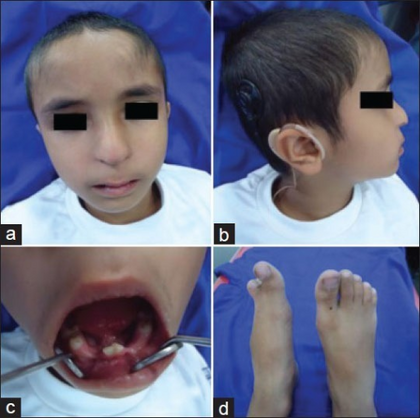Miller syndrome
| Miller syndrome | |
|---|---|
| Other names: Mandibulfacial dysostosis with postaxial limb anomalies | |
 | |
| This condition is inherited in an autosomal recessive manner. | |
Miller syndrome, also known as Genée–Wiedemann syndrome, Wildervanck–Smith syndrome or postaxial acrofacial dystosis, is an extremely rare genetic condition that manifests as craniofacial, limb and eye deformities. It is caused by a mutation in the DHODH gene. The incidence of the condition is not known, and nothing is known of its pathogenesis.
Symptoms and signs

The syndrome consists of severe micrognathia, cleft lip and/or palate, hypoplasia or aplasia of the postaxial elements of the limbs, coloboma of the eyelids and supernumerary nipples.[citation needed]
Additional features of the syndrome include downward-slanting palpebral fissures, malar hypoplasia, malformed ears, and a broad nasal ridge.
Other features include supernumerary vertebrae and other vertebral segmentation and rib defects, heart defects (patent ductus arteriosus, ventricular septal defect and ostium primum atrial septal defect), lung disease from chronic infection, single umbilical artery, absence of the hemidiaphragm, hypoplasia of the femora, ossification defects of the ischium and pubis, bilobed tongue, lung hypoplasia, and renal reflux.[citation needed]
Cause
The gene responsible for this disorder is DHODH[1][2] located at chromosome 16q22. This gene encodes an enzyme – dihydroorotate dehydrogenase – which catalyses the ubiquinone-mediated oxidation of dihydroorotate to orotate, the fourth enzymatic step in de novo pyrimidine biosynthesis. The protein is normally located on the outer surface of the inner mitochondrial membrane.[citation needed]
Genetics
A mutation in this gene was reported by Morgan in 1910 in the fruit fly Drosophila melanogaster. In the fly this mutation is characterized by wing anomalies, defective oogenesis, and malformed posterior legs.[3] In humans Miller syndrome is due to recessive mutation in the DHODH gene.[1]
Diagnosis
Differential diagnosis
The differential diagnosis includes Treacher Collins syndrome, Nager acrofacial dysostosis (preaxial cranial dysostosis). Other types of axial cranial dysostosis included the Kelly, Reynolds, Arens (Tel Aviv), Rodríguez (Madrid), Richieri-Costa and Patterson-Stevenson-Fontaine forms.[citation needed]
Treatment
Treatment may be surgery to assist with breathing, or for cleft palate or cleft lip (depending on the case by case clinical presentation)[4]
History
This condition was first described in 1969 by Genée, who assumed the condition to be an extreme form of Treacher Collins syndrome (dysostosis mandibulofacialis).[5] Wiedemann in 1975 described it as a separate entity.[6] Further cases were reported by Wildervanck in 1975[7] and by Miller et al in 1979[8] The syndrome was named the Genée-Wiedemann syndrome in 1987.[9] A family harboring Miller syndrome was the first human family to be ever sequenced with whole genome sequencing.[10]
Eponym
Genée–Wiedemann syndrome is named after two German physicians: Ekkart Genée (1936–), and his mentor Hans-Rudolf Wiedemann (1915–2006).[citation needed]
References
- ↑ 1.0 1.1 Ng SB, Buckingham KJ, Lee C, Bigham AW, Tabor HK, Dent KM, Huff CD, Shannon PT, Jabs EW, Nickerson DA, Shendure J, Bamshad MJ (January 2010). "Exome sequencing identifies the cause of a mendelian disorder". Nature Genetics. 42 (1): 30–5. doi:10.1038/ng.499. PMC 2847889. PMID 19915526.
- ↑ Roach JC, Glusman G, Smit AF, Huff CD, Hubley R, Shannon PT, Rowen L, Pant KP, Goodman N, Bamshad M, Shendure J, Drmanac R, Jorde LB, Hood L, Galas DJ (April 2010). "Analysis of genetic inheritance in a family quartet by whole-genome sequencing". Science. 328 (5978): 636–9. Bibcode:2010Sci...328..636R. doi:10.1126/science.1186802. PMC 3037280. PMID 20220176.
- ↑ Morgan TH (July 1910). "Sex limited inheritance in drosophila". Science. 32 (812): 120–2. Bibcode:1910Sci....32..120M. doi:10.1126/science.32.812.120. PMID 17759620. Archived (PDF) from the original on 2021-08-28. Retrieved 2020-11-29.
- ↑ "Miller Syndrome". NORD (National Organization for Rare Disorders). Archived from the original on 31 January 2016. Retrieved 26 August 2021.
- ↑ Genée E (1969). "Une forme de dysostose mandibulo-faciale" [A form of mandibulo-facial dysostosis]. J. De Génét. Humaine (in French). 17: 45–52.
{{cite journal}}: CS1 maint: unrecognized language (link) - ↑ Wiedemann HR (1973). "Missbildungs-Retardierungs-Syndrom mit Fehlen des 5. Strahls an Händen und Füssen, Gaumenspalte, dysplastischen Ohren und Augenlidern und radioulnarer Synostose" [Malformation retardation syndrome with absence of 5th ray on hands and feet, cleft palate, dysplastic ears and eyelids, and radioactive synostosis]. Klin Padiatr (in German). 185 (3): 181–6. PMID 4795571.
{{cite journal}}: CS1 maint: unrecognized language (link) - ↑ Wildervanck LS (1975). "Case report 28". Syndrome Identification. 3 (1): 1–13.
- ↑ Miller M, Fineman R, Smith DW (December 1979). "Postaxial acrofacial dysostosis syndrome". The Journal of Pediatrics. 95 (6): 970–5. doi:10.1016/S0022-3476(79)80285-1. PMID 501501.
- ↑ Opitz JM, Stickler GB (August 1987). "The Genée-Wiedemann syndrome, an acrofacial dysostosis--further observation". American Journal of Medical Genetics. 27 (4): 971–5. doi:10.1002/ajmg.1320270427. PMID 3425606.
- ↑ McAuliffe, Kathleen (April 27, 2011). "#5: Family Genomics Links DNA to Disease". Discover. January/February 2011. Archived from the original on August 28, 2021. Retrieved November 29, 2020.
External links
| Classification | |
|---|---|
| External resources |
- Pages with script errors
- CS1 maint: unrecognized language
- CS1: long volume value
- All articles with unsourced statements
- Articles with unsourced statements
- Articles with unsourced statements from November 2020
- Articles with invalid date parameter in template
- Inborn errors of purine-pyrimidine metabolism
- Syndromes affecting the eyes
- Syndromes with cleft lip and/or palate
- Rare syndromes